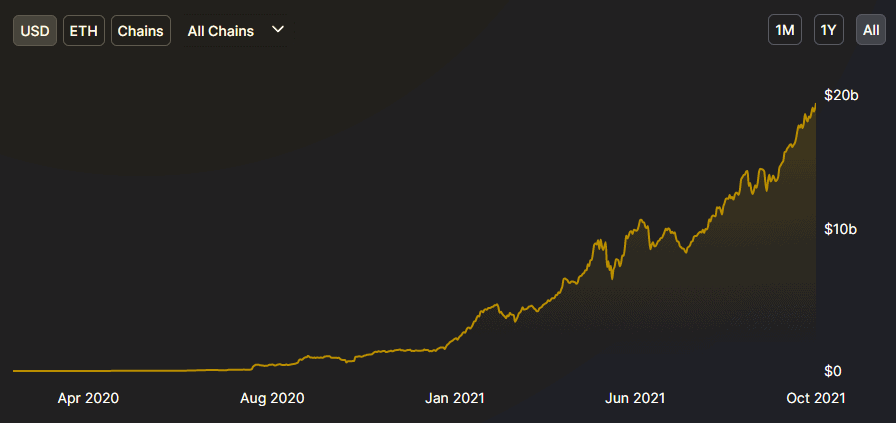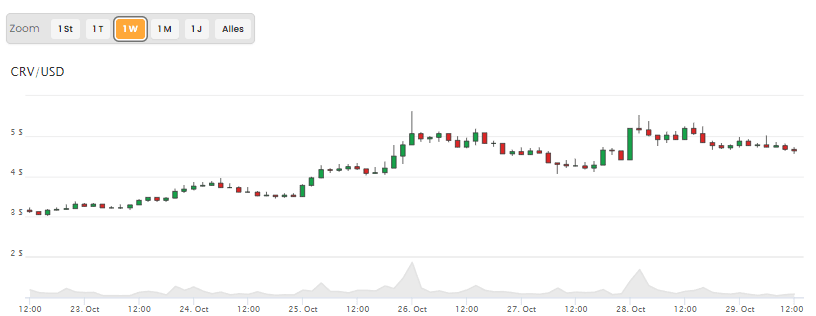A hacker loots over $ 100 million on Cream Finance and a new report by the Financial Action Task Force (FATF) proposes new rules for Decentralized Finance (DeFi).
After the broad DeFi sector has performed comparatively poorly in recent weeks , some tokens have turned around this week. The token of the decentralized exchange (DEX) aggregator 1inch (1INCH) increased by over 20 percent on a weekly basis . 1INCH’s sudden price explosion was due to the announcement that the project would be integrated into Exodus’ crypto wallet by default. Exodus users now have the opportunity to trade their tokens directly in their wallet via 1inch’s DEX aggregator.
Another DeFi project that has performed strongly this week is Curve (CRV). Just like PancakeSwap or Uniswap (UNI), Curve is a DEX. In contrast to the two DEX heavyweights, Curve specializes primarily in offering token swaps for cryptocurrencies that are stable in value. With a Total Value Locked (TVL) of almost 19 billion US dollars, Curve is the largest DeFi protocol in the entire crypto space, according to the Defi Llama analysis platform .

On a weekly basis, CRV is up 61.23 percent and is trading just under $ 5 at press time .

Key factors behind the ongoing CRV rally are the incentives investors are currently receiving for long-term staking of CRV. Almost 90 percent of all CRV tokens are currently in staking smart contracts, with an average blocking period of 3.68 years. This development has led to a severe supply shortage of CRV – if the demand for CRV remains the same or increases, this means price growth.
The Financial Task Force (FATF) proposes new rules for DeFi
The international organization FATF proposed new guidelines on the regulation of digital assets (VASP) in a report published on October 28th . In addition to non-fungible tokens (NFTs), this report also looked at decentralized finance.
All companies that offer services in connection with stablecoins and blockchain-based DeFi protocols should therefore be obliged to closely monitor the data of their customers in order to prevent money laundering and terrorist financing. In plain language, this means that every founder, owner and operator of a DeFi protocol should carry out a know-your-customer procedure (KYC).
Unsurprisingly, the reactions in the DeFi community were quite negative. Miller Whitehouse-Levine, the policy director of the recently formed DeFi Education Fund, criticized the FATF’s guidelines in several tweets . He doesn’t think that decentralized finance can be easily integrated into the existing guidelines of the traditional financial world. He is also of the opinion that it will be a long time before the FATF’s requirements can be implemented in practice.
Notwithstanding these concerns, the practical impact of these guidelines is likely to be relatively limited. We are still a long way from doing this in practice.
Cream Finance: DeFi hack clears $ 130 million
One reason why regulation in the DeFi space can make sense was recently demonstrated by a hacker attack on Cream Finance (CREAM). The DeFi protocol fell victim to a hacker attack this week for the third time in its young history. The attacker stole around 130 million US dollars . As is so often the case, a security hole in the smart contracts made the hack possible.
PeckShield uncovered the vulnerability . The blockchain security service provider announced that the attacker used a flash loan to get the funds in the smart contracts. According to blockchain records, around 130 million US dollars were stolen in this way.
Extras
Intro:
For some time now, decentralized finance, or DeFI (for Decentralized Finance in English), has started to be talked about a lot in the cryptosphere. The resulting applications can offer a multitude of possibilities to cryptocurrency users.
What is Defi (Decentralized Finance)?
What is DeFi and what are its origins? Decentralized Finance simply aims to offer an ecosystem of financial services without intermediaries. In our traditional financial system, it is mainly the banks which are the depositaries of the funds and which guarantee the exchanges. With DeFi, users keep their funds in their personal wallet (or wallet ) and transactions are done directly from user to user via blockchain and digital “contracts” created by specific applications .
DeFi is open to everyone and, like any open-source system, each user can contribute their ideas and contribute to its development, thus offering a strong potential for financial applications . And whether you are a beginner or a seasoned amateur, everyone can learn about and deepen their knowledge of decentralized finance and its challenges.
In everyone’s mouth today, the first real use relating to decentralized finance appeared in 2009 with Bitcoin and its peer-to-peer system , that is to say a concrete means of directly exchanging funds. assets between users without having to go through an intermediary as in traditional finance.
The main applications and possibilities of DeFi
As we have seen previously, decentralized finance is defined as a new financial ecosystem outside regulated markets and it is expanding rapidly. The main services offered by traditional banks have appeared and are therefore now accessible with a simple smartphone , anywhere in the world, even for those who do not have access to the banking system.
It is now possible to borrow or lend money against interest via certain applications; this can have many advantages over conventional loans. Obtaining guarantees, insurance or mortgages is now possible. In these cases, it is often stablecoins that will be used and help fight against the volatility of cryptocurrencies by being indexed to the dollar, for example, in order to have the most stable value possible.
The limits of DeFi
True decentralized finance would, by definition, require that there be no intermediary or centralization of projects and that the system develops by itself; However, in order to develop, the platforms need to set up a team and funds and therefore to pool skills. Each platform therefore tries to create its own DeFi ecosystem which will therefore compete with the ecosystems of other platforms.
Obviously, regulators are also watching the development of decentralized finance very closely to find and give it a regulatory framework. The subject is also currently under discussion within the European Commission.

